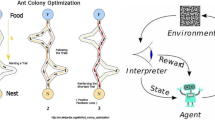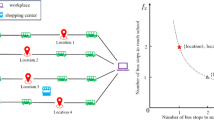Abstract
Handoff and cabling costs management plays an important role in the design of cellular mobile networks. Efficient assigning of cells to switches can have a significant impact on handoff and cabling cost. Assignment of cells to switches problem (ACTSP) in cellular mobile network is NP-hard problem and consequently cannot be solved by exact methods. In this paper a new memetic algorithm which is obtained from the combination of learning automata (LA) and local search is proposed for solving the ACTSP in which the learning automata keeps the history of the local search process and manages the problem’s constraints. The proposed algorithm represents chromosome as object migration automata (OMAs), whose states represent the history of the local search process. Each state in an OMA has two attributes: the value of the gene (allele), and the degree of association with those values. The local search changes the degree of association between genes and their values. To show the superiority of the proposed algorithm several computer experiments have been conducted. The obtained results confirm the efficiency of proposed algorithm in comparison with the existing algorithms such as genetic algorithm, memetic algorithm, and a hybrid Hopfield network-genetic algorithm.

















Similar content being viewed by others
References
Toril M, Guerrero-García P, Luna-Ramírez S, Wille V (2012) An efficient integer programming formulation for the assignment of base stations to controllers in cellular networks. Comput Netw 56:303–314
Chaurasia SN, Singh A (2014) A hybrid evolutionary approach to the registration area planning problem. Appl Intell 41:1127–1149
Khuri S, Chiu T (1997) Heuristic algorithms for the terminal assignment problem. In: Proceedings of the 1997 ACM symposium on applied computing, pp 247–251
Quintero A, Pierre S (2003) Sequential and multi-population memetic algorithms for assigning cells to switches in mobile networks. Comput Netw 43:247–261
Salcedo-Sanz S, Yao X (2008) Assignment of cells to switches in a cellular mobile network using a hybrid Hopfield network-genetic algorithm approach. Appl Soft Comput 8:216–224
Vafadarnikjoo A, Firouzabadi SMAK, Mobin M, Roshani A (2015) A meta-heuristic approach to locate optimal switch locations in cellular mobile networks
Debbat F, Bendimerad FT (2014) Assigning cells to switches in cellular mobile networks using hybridizing API algorithm and Tabu Search. Int J Commun Syst 27:4028–4037
Fournier JR, Pierre S (2005) Assigning cells to switches in mobile networks using an ant colony optimization heuristic. Comput Commun 28:65–73
Quintero A, Pierre S (2003) Evolutionary approach to optimize the assignment of cells to switches in personal communication networks. Comput Commun 26:927–938
Quintero A, Pierre S (2003) Assigning cells to switches in cellular mobile networks: a comparative study. Comput Commun 26:950–960
Menon S, Gupta R (2004) Assigning cells to switches in cellular networks by incorporating a pricing mechanism into simulated annealing. IEEE Trans Syst Man Cybern Part B: Cybern 34:558–565
Goudos SK, Baltzis KB, Bachtsevanidis C, Sahalos JN (2010) Cell-to-switch assignment in cellular networks using barebones particle swarm optimization. IEICE Electron Express 7:254–260
Wang J, Cai Y, Zhou Y, Wang R, Li C (2011) Discrete particle swarm optimization based on estimation of distribution for terminal assignmentproblems. Comput Indus Eng 60:566–575
Vroblefski M, Brown EC (2006) A grouping genetic algorithm for registration area planning, vol 34
Chaurasia SN, Singh A (2015) A hybrid swarm intelligence approach to the registration area planning problem. Inform Sci 302:50–69
James T, Vroblefski M, Nottingham Q (2007) A hybrid grouping genetic algorithm for the registration area planning problem. Comput Commun 30:2180–2190
Narendra KS, Thathachar MAL (1989) Learning automata: an introduction. Prentice-Hall Inc.
Thathachar MAL, Sastry PS (2002) Varieties of learning automata: an overview. IEEE Trans Syst Man Cybern Part B: Cybern 32:711–722
Rezapoor Mirsaleh M, Meybodi MR (2016) A new memetic algorithm based on cellular learning automata for solving the vertex coloring problem. Memetic Comput 8:211–222
Oommen B, Hansen E (1984) The asymptotic optimality of discretized linear reward-inaction learning automata. IEEE Trans Syst Man Cybern 14:542–545
Johnoommen B (1986) Absorbing and ergodic discretized two-action learning automata. IEEE Trans Syst Man Cybern 16:282–293
Akbari Torkestani J, Meybodi MR (2010) Learning automata-based algorithms for finding minimum weakly connected dominating set in stochastic graphs. Int J Uncertain Fuzziness Knowledge-Based Syst 18:721–758
Rezapoor Mirsaleh M, Meybodi MR (2015) A learning automata-based Memetic algorithm. Genet Program Evolvable Mach 16:399–453
Akbari Torkestani J (2012) An adaptive focused Web crawling algorithm based on learning automata. Appl Intell 37:586–601
Vafashoar R, Meybodi MR, Momeni Azandaryani AH (2012) CLA-DE: a hybrid model based on cellular learning automata for numerical optimization. Appl Intell 36:735–748
Rezapoor Mirsaleh M, Meybodi MR (2017) Balancing exploration and exploitation in memetic algorithms: a learning automata approach. Comput Intell
Akbari Torkestani J, Meybodi MR (2010) An efficient cluster-based CDMA/TDMA scheme for wireless mobile ad-hoc networks: a learning automata approach. J Netw Comput Appl 33:477–490
Akbari Torkestani J, Meybodi MR (2010) Mobility-based multicast routing algorithm for wireless mobile Ad-hoc networks: a learning automata approach. Comput Commun 33:721–735
Akbari Torkestani J, Meybodi MR (2010) An intelligent backbone formation algorithm for wireless ad hoc networks based on distributed learning automata. Comput Netw 54:826–843
Beigy H, Meybodi MR (2011) Learning automata based dynamic guard channel algorithms. Comput Electric Eng 37:601–613
Akbari Torkestani J, Meybodi MR (2011) LLACA: an adaptive localized clustering algorithm for wireless ad hoc networks. Comput Electric Eng 37:461–474
Jahanshahi M, Dehghan M, Meybodi M (2013) LAMR: learning automata based multicast routing protocol for multi-channel multi-radio wireless mesh networks. Appl Intell 38:58–77
Rezapoor Mirsaleh M, Meybodi MR (2016) A Michigan memetic algorithm for solving the community detection problem in complex network. Neurocomputing 214:535–545
Meybodi RM (1983) Learning automata and its application to priority assignment in a queueing system with unknown characteristics, Ph.D. thesis, Departement of Electrical Engineering and Computer Science, University of Oklahoma, Norman, Oklahoma USA
Tsetlin ML (1973) Automaton theory and modeling of biological systems, vol 102. Academic Press, New York
Hashim A, Amir S, Mars P (1986) Application of learning automata to data compression. Adapt Learn Syst, 229–234
Manjunath B, Chellappa R (1988) Stochastic learning networks for texture segmentation. In: Twenty-Second Asilomar conference on signals, systems and computers, pp 511–516
Rezapoor Mirsaleh M, Meybodi MR (2017) A Michigan memetic algorithm for solving the vertex coloring problem. J Comput Sci
Frost GP (1998) Stochastic optimisation of vehicle suspension control systems via learning automata, Ph.D. Thesis, Department of Aeronautical and Automotive Engineering. Loughborough University, Loughborough
Howell M, Frost G, Gordon T, Wu Q (1997) Continuous action reinforcement learning applied to vehicle suspension control. Mechatronics 7:263–276
Unsal C, Kachroo P, Bay JS (1999) Multiple stochastic learning automata for vehicle path control in an automated highway system. IEEE Trans Syst Man Cybern Part A: Syst Humans 29:120–128
Beigy H, Meybodi MR (2009) A learning automata-based algorithm for determination of the number of hidden units for three-layer neural networks. Int J Syst Sci 40:101–118
Meybodi MR, Beigy H (2001) Neural network engineering using learning automata: determining of desired size of three layer feed forward neural networks. J Faculty Eng (University of Tehran) 34:1–26
Oommen BJ, Croix DS (1997) String taxonomy using learning automata. IEEE Trans Syst Man Cybern Part B: Cybern 27:354–365
Barto AG, Jordan MI (1987) Gradient following without back-propagation in layered networks. In: 1st Int. conference neural nets. San Diego
Thathachar M, Phansalkar VV (1995) Learning the global maximum with parameterized learning automata. IEEE Trans Neural Netw 6:398–406
Oommen BJ, Ma DCY (1988) Deterministic learning automata solutions to the equipartitioning problem. IEEE Trans Comput 37:2–13
Author information
Authors and Affiliations
Corresponding author
Rights and permissions
About this article
Cite this article
Rezapoor Mirsaleh, M., Meybodi, M.R. Assignment of cells to switches in cellular mobile network: a learning automata-based memetic algorithm. Appl Intell 48, 3231–3247 (2018). https://doi.org/10.1007/s10489-018-1136-z
Published:
Issue Date:
DOI: https://doi.org/10.1007/s10489-018-1136-z




